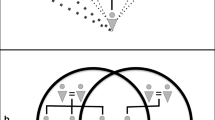Abstract
Bowen theory hypothesizes that undifferentiation or fusion between the generations influences nuclear family functioning. Using qualitative and quantitative methods this longitudinal study tested this idea with 49 newly developing nuclear families. Analysis of the first five years of data offered support to the hypothesis. Qualitative analyses of the participants' interviews gave the strongest support for higher levels of intergenerational fusion being associated with higher levels of nuclear family symptomology. Quantitative analyses also supported the hypothesis. The association between intergenerational fusion, as measured by couple-parent fusion and family financial dependence, and nuclear family functioning increased over the five-year period.
Similar content being viewed by others
REFERENCES
Ainsworth, M.D.S., Blehar, M.C., Waters, E., & Wall, S. (1978). Patterns of attachment: A psychological study of the strange situation. Hillsdale, NJ: Erlbaum.
Atkinson, L., & K.J. Zucker (Eds.). (1997). Attachment and psychopathology. New York: Guilford Press.
Baker, K. & J. Gippenreiter. (1996). The effects of Stalin's purge on three generations of Russian families, Family Systems, 3, 5–35.
Bowen, M. (1978). Family therapy in clinical practice. New York: Jason Aronson.
Bowlby, J. (1988). A secure base: Parent-child attachment and healthy human development. New York: Basic Books.
Bray, J.H., Harvey, D.M., & Williamson, D.S. (1987). Intergenerational family relationships: An evaluation of theory and measurement. Psychotherapy, 24, 516–528.
Bray, J. H., Williamson, D.S., & Malone, P.E. (1984). Personal authority in the family system: Development of a questionnaire to measure personal authority in intergenerational family processes. Journal of Marital and Family Therapy 10(2), 167–78.
Cattell, R.B. (1944). Psychological measurement: Normative, ipsative, interactive. Psychological Review, 51, 292–303.
Cowan, C., & P. Cowan. (1992). When partners become parents. New York: Basic Books.
Dillard, C. K., & Protinsky, H.O. (1985). Emotional cutoff: A comparative analysis of clinical versus nonclinical populations. International Journal of Family Psychiatry 6(4) 339–349.
Donley, M. (1993). Attachment and the emotional unit. Family Process, 32:3–20.
Feeney, J. A., & Noller, P. (1990). Attachment style as a predictor of adult romantic relationships. Journal of Personality and Social Psychology 58, 281–291.
Haber, J. (1990). The Haber level of differentiation of self scale. (pp. 320–331). In L. Strickland & C. Waltz (eds.), The measurement of nursing outcomes. New York: Springer.
Harrison, V. (1997). Patterns of ovulation, reactivity, and family emotional process. In C. S. Carter, I. I. Lederhendler, & Brian Kirkpatrick (Eds.), The integrative neurobiology of affiliation, Annals of New York Academy of the Sciences, 807, 522–524.
Harvey, D.M., Curry, C.J., & Bray, J. H. (1991). Individuation and intimacy in intergenerational relationships and health: Patterns across two generations. Journal of Family Psychology, 5, 204–236.
Klever, P. (2001). The nuclear family functioning scale: Initial development and preliminary validity. Families, Systems & Health 19:397–410.
Main, M. (1995) Attachment: Overview, with implications for clinical work. In S. G oldberg, R. Muir, & J. Kerr (Eds.) Attachment theory: Social, developmental and clinical psychology (pp. 407–474). Hillsdale, NJ: Analytic Press.
Main, M. & Goldwyn, R. (1984). Adult attachment scoring and classification system. Unpublished manuscript, University of California at Berkeley.
Main, M., Kaplan, N., & Cassidy, J. (1985). Security in infancy, childhood, and adulthood: A move to the level of representation. Monographs of the Society for Research in Child Development, 50, 66–104.
Main, M. & Solomon, J. (1990). Procedures for identifying infants as disorganized/disoriented during the Ainsworth strange situation. In M.T. Greenber, D. Cicchetti, & E. M. Cummings (Eds.) Attachment in the preschool years: Theory, research, and intervention (pp. 121–160). Chicago: University of Chicago Press.
McCollum, E. E. (1991). A scale to measure Bowen's concept of emotional cutoff. Contemporary Family Therapy, 13(3), 247–253.
Pianta, R.C., Egeland, B., and Adam, E.K. (1996). Adult attachment classification and self-reported psychiatric symptomatology as assessed by the Minnesota Multiphasic Personality Inventory-2. Journal of Consulting and Clinical Psychology, 64, 273–281.
Rubin, D.C. (1986). Autobiographical memory. Cambridge, UK: Cambridge University Press.
Schacter, D.L. (1996). Searching for memory: The brain, the mind, and the past. New York: Basic Books.
Skowron, E. A., & Friedlander, M.L. (1998) The differentiation of self inventory: Development and initial validation. Journal of Counseling Psychology, 45(3), 235–246.
Spanier, G. (1976). Measuring dyadic adjustment: New scales for assessing the quality of marriage and similar dyads, Journal of Marriage and the Family, 38, 15–28.
Valliant, G. E. (1978). Natural history of male psychological health: VI. Correlates of successful marriage and fatherhood. American Journal of Psychiatry, 135(6), 653–659.
Weigert, S. (2000). The predictive accuracy of normative and interactive measurement of personality. Unpublished dissertation. Georgetown University, Washington, DC.
Weiner, E.L. (1990). Bowen's concept of emotional connectedness to former spouse and family of origin as a moderator of health in a divorced population: A partial test of Bowen theory. Unpublished doctoral dissertation. Kansas State University, Manhattan, Kansas.
Rights and permissions
About this article
Cite this article
Klever, P. Intergenerational Fusion and Nuclear Family Functioning. Contemporary Family Therapy 25, 431–451 (2003). https://doi.org/10.1023/A:1027312819938
Issue Date:
DOI: https://doi.org/10.1023/A:1027312819938




